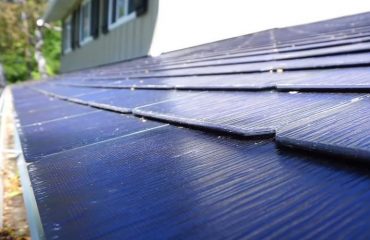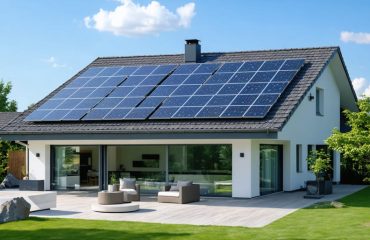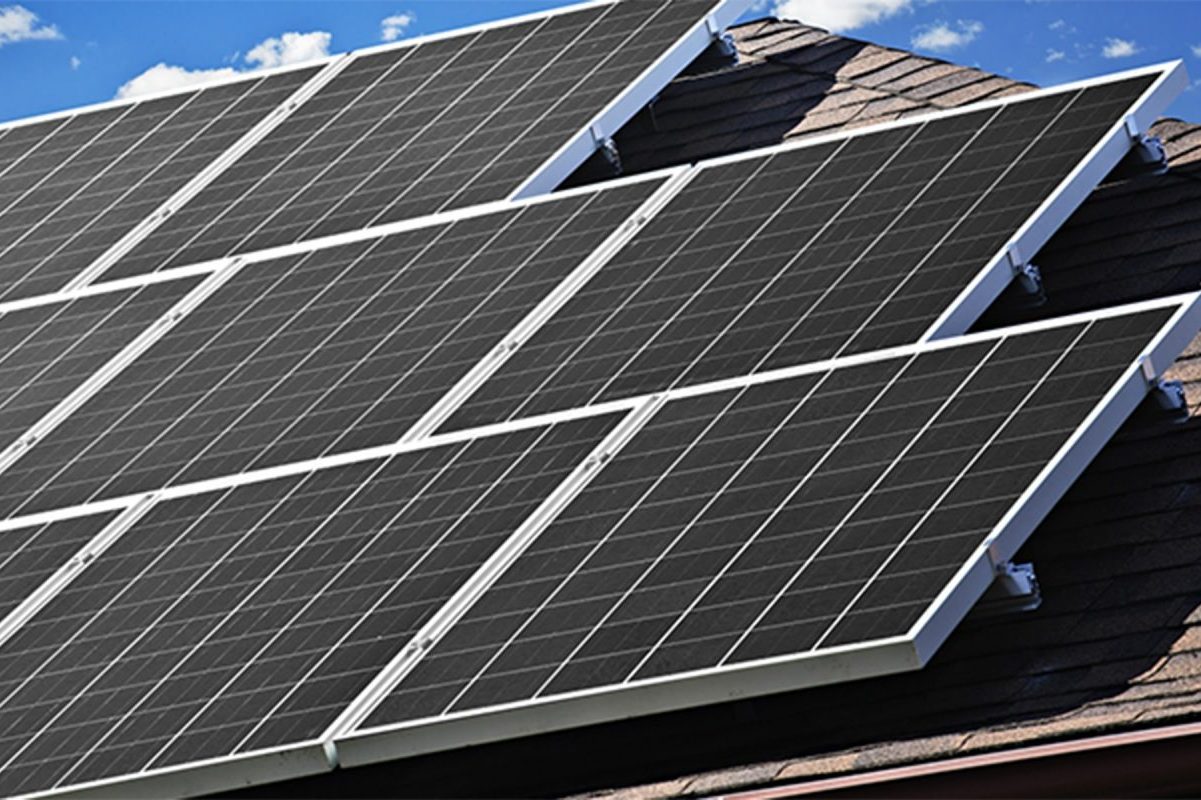Imagine a home that not only generates its own clean, renewable energy from the sun but also stores that power for use anytime, even during grid outages. A whole home solar system with battery backup turns this vision into reality, offering homeowners unparalleled energy independence, savings, and resilience.
By combining rooftop solar panels with advanced battery storage, these innovative systems capture the sun’s abundant energy during the day, using it to power your home and charging the batteries simultaneously. When night falls or clouds roll in, the batteries seamlessly take over, keeping your lights on and appliances running without interruption.
Beyond providing 24/7 clean energy, whole home solar and storage systems also insulate you from rising utility rates, potentially saving thousands on electricity bills over the system’s lifetime. And with the ability to operate independently of the grid during blackouts, your home remains a beacon of comfort and security, no matter the circumstances outside.
As we navigate an era of increasing energy uncertainty and climate instability, investing in a whole home solar system with battery backup is not just a smart financial move but also a powerful statement of self-reliance and environmental stewardship. It’s a brighter future for your home, your community, and the planet we all share.

How Whole Home Solar & Battery Systems Work
Solar Panels: Harnessing the Sun’s Energy
Solar panels are the key component of a whole home solar system, converting the sun’s abundant energy into usable electricity for your household. These panels are made up of photovoltaic (PV) cells, which utilize semiconductor materials like silicon to absorb sunlight and generate an electric current through a process called the photovoltaic effect. Modern solar panels are highly efficient, with many models capable of converting over 20% of the solar energy they receive into electricity. This means that even on cloudy days, your solar panels can still generate a significant amount of power for your home. As solar technology continues to advance, panels are becoming increasingly efficient, durable, and affordable, making them an excellent investment for homeowners looking to reduce their carbon footprint and save money on energy costs in the long run.
Battery Storage: Saving Surplus Power for Later
Batteries are the key to storing excess solar energy generated during the day for use at night or during power outages. When your solar panels produce more electricity than your home needs, the surplus is sent to charge your battery storage system. Later, when your panels aren’t generating enough power, such as after sunset or on cloudy days, your home can draw energy from these charged batteries, ensuring you have a reliable, sustainable power supply 24/7.
Battery backup also provides energy security during grid outages. If a storm knocks out power in your area, your solar panel backup battery will automatically kick in, keeping your lights on and essential appliances running. With proper sizing, a solar battery can power your home for hours or even days until grid power is restored. This energy independence brings peace of mind and preparedness.
Inverters: Converting Solar DC to Household AC
Inverters are a crucial component in a whole home solar system with battery backup, converting the direct current (DC) electricity generated by solar panels into alternating current (AC) electricity that powers household appliances. Without an inverter, the solar energy would be unusable for most home devices. These devices seamlessly integrate with your solar panels and battery storage system, ensuring a steady flow of usable electricity throughout your home. By converting DC to AC power, inverters enable you to directly use the clean energy your solar panels produce, reducing your reliance on the grid and maximizing your energy savings.
Benefits of Going Solar with Battery Backup
Slash Your Electric Bills
Generating your own clean, renewable electricity with a whole home solar system can drastically reduce or even eliminate your monthly electric bills. By harnessing the power of the sun, you can slash your electric bills and achieve energy independence. Solar panels convert sunlight into electricity, which can power your home appliances, lighting, and electronics. When your system generates more electricity than you need, the excess is sent back to the grid, earning you credits on your utility bill through net metering programs. With battery backup, you can store excess solar energy for use during peak demand hours or power outages, further reducing your reliance on the grid. Over time, the savings on your electric bills can offset the initial investment in your solar system, providing long-term financial benefits while contributing to a cleaner environment.
Protect Against Power Outages
With a solar battery backup system, you can enjoy uninterrupted power even during grid outages. The batteries store excess solar energy generated during the day, allowing you to draw upon this stored power when the grid goes down or at night when your panels aren’t producing. This means your essential appliances, lights, and devices will continue running, providing peace of mind and convenience. Advanced battery systems can power your entire home for extended periods, depending on the size of the battery bank and your energy usage. Some systems even allow you to prioritize which circuits receive backup power. With real-time monitoring, you can track your battery’s charge level and performance, ensuring you’re always prepared. Say goodbye to the inconvenience and potential dangers of power outages with a reliable solar battery backup system that keeps your home running smoothly.

Reduce Your Carbon Footprint
By installing a whole home solar system with battery backup, you can significantly reduce your carbon footprint and contribute to a cleaner, greener planet. Solar energy is a renewable resource that generates electricity without emitting harmful greenhouse gases or pollutants. Unlike fossil fuels, solar power doesn’t contribute to air pollution, water pollution, or climate change. By generating your own clean energy, you’ll be less reliant on the grid and can reduce your carbon footprint by lowering your household’s overall emissions. Plus, any excess solar energy you generate can be sent back to the grid, helping to green the electricity supply for your entire community. With a whole home solar system and battery backup, you’ll not only be powering your home with clean energy but also contributing to a more sustainable future for generations to come.
Is Whole Home Solar & Battery Right for You?

Evaluating Your Sun Exposure
When evaluating your home’s suitability for solar panels, one of the most crucial factors is having an unshaded, south-facing roof space. Solar panels generate the most electricity when exposed to direct sunlight for the majority of the day. A south-facing roof in the Northern Hemisphere ensures optimal sun exposure, maximizing your system’s energy production. Additionally, your roof should be relatively free from shade cast by trees, chimneys, or neighboring buildings. Even partial shading can significantly reduce the efficiency of your solar panels. If your roof doesn’t meet these criteria, ground-mounted solar panels or a solar carport may be viable alternatives. Assessing your sun exposure is essential for determining the feasibility and potential benefits of installing a whole home solar system with battery backup.
Sizing Your Solar & Battery System
To properly size your solar and battery system, consider your average daily energy consumption and peak usage. Look at past utility bills to calculate your kilowatt-hour (kWh) usage. Factor in any planned changes, such as electric vehicle charging or home expansions. A reputable solar installer can help assess your needs and recommend an appropriately sized system. They’ll consider your roof’s solar potential, shading, and local climate to design a system that offsets your energy usage effectively. Aim for a system that generates enough power to cover your needs and has sufficient battery capacity for your desired backup duration during outages. Proper sizing ensures you maximize savings, have reliable backup power, and optimize your investment in clean, renewable energy for your home.
Getting Started with Whole Home Solar & Battery
Find a Reputable Solar Installer
When choosing a solar installer for your whole home solar system with battery backup, it’s crucial to find a reputable company with experienced, certified professionals. Look for installers with NABCEP certification, which ensures they meet rigorous standards for knowledge and experience in the solar industry. To ensure you’re getting the best value and quality, obtain multiple quotes from different installers and compare their proposals, warranties, and customer reviews. A reputable installer will conduct a thorough assessment of your home’s energy needs, solar potential, and provide a detailed, transparent quote. They should also guide you through the process, including permitting, installation, and connecting to the grid.
Incentives & Financing Options
Going solar is more affordable than ever, thanks to various incentives and financing options. The federal solar tax credit allows you to deduct 26% of your solar installation costs from your taxes. Many states also offer additional tax credits and rebates. Net metering enables you to sell excess solar energy back to the grid, further reducing your bills. Solar financing options, such as loans and leases, make it easy to go solar with little to no upfront costs. By combining these incentives and financing solutions, you can significantly lower the cost of installing a whole home solar system with battery backup and enjoy long-term savings on your energy bills.
Permitting & Installation Timeline
Installing a whole home solar system with battery backup involves several key steps in terms of permitting and installation. First, you’ll need to submit permits to your local building department for approval. This typically includes electrical and structural plans. Once approved, your solar installer will schedule a date for the installation. The actual installation process usually takes 1-3 days, depending on the size and complexity of your system. This includes mounting the solar panels, connecting the electrical wiring, and installing the battery backup system. After installation, your system will need to be inspected and approved by the local building department before it can be activated. The entire process, from permitting to final approval, typically takes 4-8 weeks.
In conclusion, whole home solar systems with battery backup offer a multitude of benefits for homeowners looking to embrace sustainable living, reduce their carbon footprint, and save money on energy bills. By generating clean solar power and storing excess energy in batteries, you can effectively power your entire home day and night while minimizing reliance on the grid. This not only contributes to a greener future but also provides energy security during power outages. With advancements in technology and increasing affordability, now is an excellent time to explore the possibilities of whole home solar and battery systems. We encourage you to take the first step by assessing your home’s suitability and consulting with a reputable solar installer. By making the switch to solar and battery, you can enjoy the peace of mind that comes with clean, reliable energy while making a positive impact on the environment and your wallet.








